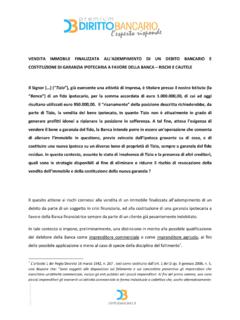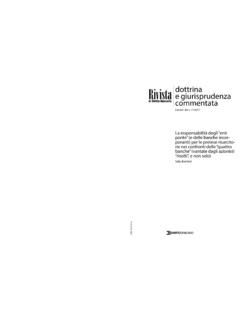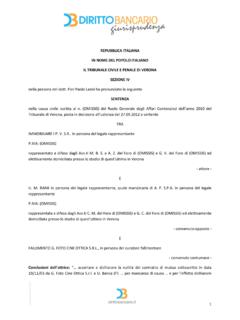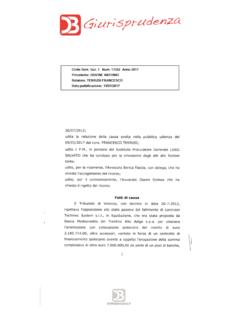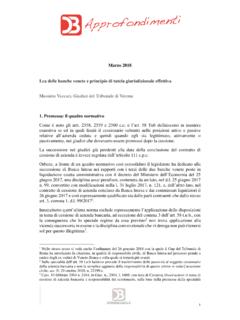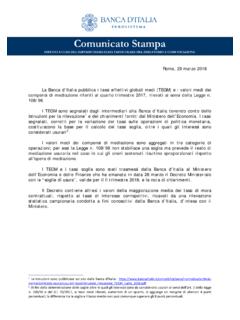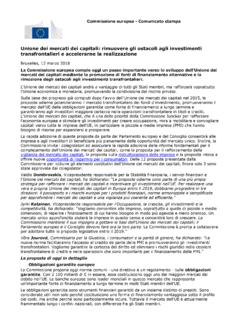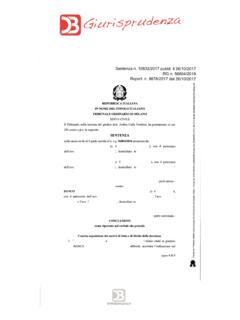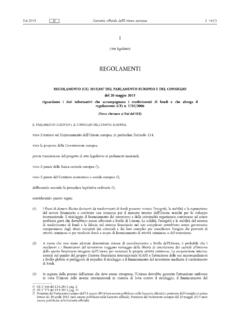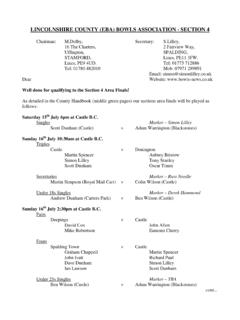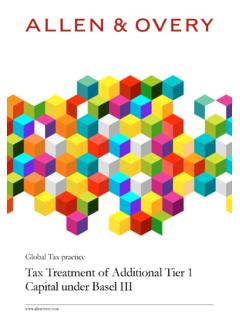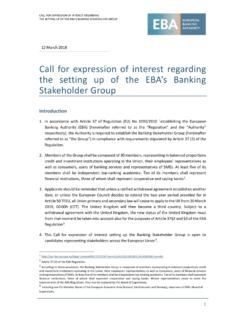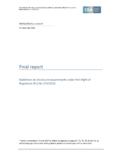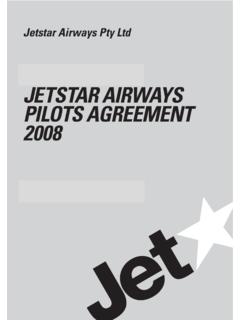Transcription of Final Report - Diritto Bancario
1 Final Report ON GUIDELINES ON INTERNAL GOVERNANCE EBA/GL/2017/11 26 September 2017 Final Report Guidelines on internal governance under Directive 2013/36/EU Final Report ON GUIDELINES ON INTERNAL GOVERNANCE Contents Executive Summary 3 Background and rationale 5 1. Compliance and reporting obligations 12 Status of these guidelines 12 Reporting requirements 12 2. Subject matter, scope and definitions 13 Subject matter 13 Addressees 13 Scope of application 13 Definitions 14 3. Implementation 16 Date of application 16 Repeal 16 4. Guidelines 17 Title I Proportionality 17 Title II Role and composition of the management body and committees 18 1 Role and responsibilities of the management body 18 2 Management function of the management body 20 3 Supervisory function of the management body 21 4 Role of the chair of the management body 22 5 Committees of the management body in its supervisory function 22 Setting up committees 22 Composition of committees 23 Committees processes 24 Role of the risk committee 25 Role of the audit committee 26 Combined committees 27 Title III Governance framework 28 6 Organisational framework and structure 28 Organisational framework 28
2 Know your structure 28 Complex structures and non-standard or non-transparent activities 30 7 Organisational framework in a group context 31 8 Outsourcing policy 33 Final Report ON GUIDELINES ON INTERNAL GOVERNANCE 2 Title IV Risk culture and business conduct 33 9 Risk culture 33 10 Corporate values and code of conduct 35 11 Conflict of interest policy at institutional level 36 12 Conflict of interest policy for staff 36 13 Internal alert procedures 39 14 Reporting of breaches to competent authorities 40 Title V Internal control framework and mechanisms 41 15 Internal control framework 41 16 Implementing an internal control framework 42 17 Risk management framework 43 18 New products and significant changes 45 19 Internal control functions 46 Heads of the internal control functions 46 Independence of internal control functions 47 Combination of internal control functions 47 Resources of internal control functions 47 20 Risk management function 47 RMF s role in risk strategy and decisions 48 RMF s role in material changes 49 RMF s role in identifying, measuring, assessing, managing, mitigating.
3 Monitoring and reporting on risks 49 RMF s role in unapproved exposures 50 Head of the risk management function 50 21 Compliance function 51 22 Internal audit function 52 Title VI Business continuity management 53 Title VII Transparency 54 Annex I Aspects to take into account when developing an internal governance policy 56 5. Accompanying documents 58 Draft cost-benefit analysis/impact assessment 58 Feedback on the public consultation 64 Final Report ON GUIDELINES ON INTERNAL GOVERNANCE 3 Executive Summary In recent years, internal governance issues have received increased attention from various international bodies. Their main aim has been to correct institutions weak or superficial internal governance practices, as identified during the financial crisis.
4 Recently, there has been a greater focus on conduct-related shortcomings and activities in offshore financial centres. Sound internal governance arrangements are fundamental if institutions individually and the banking system they form are to operate well. Directive 2013/36/EU reinforces the governance requirements for institutions and in particular stresses the responsibility of the management body for sound governance arrangements; the importance of a strong supervisory function that challenges management decision-making; and the need to establish and implement a sound risk strategy and risk management framework.
5 To further harmonise institutions internal governance arrangements, processes and mechanisms within the EU in line with the requirements introduced by Directive 2013/36/EU, the European Banking Authority (EBA) is mandated by Article 74 of Directive 2013/36/EU to develop guidelines in this area. The guidelines apply to all institutions regardless of their governance structures (unitary board, dual board or other structure), without advocating or preferring any specific structure, as set out specifically in the scope of application. The terms management body in its management function and management body in its supervisory function should be interpreted throughout the guidelines in accordance with the applicable law within each Member State.
6 The guidelines complete the various governance provisions in Directive 2013/36/EU, taking into account the principle of proportionality, by specifying the tasks, responsibilities and organisation of the management body, and the organisation of institutions, including the need to create transparent structures that allow for supervision of all their activities; the guidelines also specify requirements aimed at ensuring the sound management of risks across all three lines of defence and, in particular, set out detailed requirements for the second line of defence (the independent risk management and compliance function) and the third line of defence (the internal audit function).
7 The guidelines are based on an earlier set of guidelines on internal governance and in particular add additional requirements that aim to foster a sound risk culture implemented by the management body, to strengthen the management body s oversight of the institution s activities and to strengthen the risk management frameworks of institutions. Additional guidelines have been provided to further increase the transparency of institutions offshore activities and to ensure the consideration of risks within institutions change processes. Final Report ON GUIDELINES ON INTERNAL GOVERNANCE 4 Next steps The EBA has published its guidelines on internal governance, which will enter into force on 30 June 2018.
8 The existing guidelines on internal governance, published on 27 September 2011, will be repealed at the same time. On the same date, the EBA and ESMA joint guidelines on the assessment of the suitability of members of the management body and key function holders will come into force. Final Report ON GUIDELINES ON INTERNAL GOVERNANCE 5 Background and rationale 1. Trust in the reliability of the financial system is crucial for its proper functioning and a prerequisite if it is to contribute to the economy as a whole. Consequently, effective internal governance arrangements are fundamental if institutions individually and the banking system they form are to operate well.
9 2. In recent years, internal governance issues have received increased attention from various international bodies. Their main aim has been to correct institutions weak or superficial internal governance practices, as identified during the financial crisis. These faulty practices, while not a direct trigger for the financial crisis, were closely associated with it and were questionable. In addition, recently, there has been a greater focus on conduct-related shortcomings and activities in offshore financial centres. 3. In some cases, at the time of the financial crisis the absence of effective checks and balances within institutions resulted in a lack of effective oversight of management decision-making, which led to short-term oriented and excessively risky management strategies.
10 Weak oversight by the management body in its supervisory function has been identified as a contributing factor. The management body, both in its management function and, in particular, in its supervisory function, might not have understood the complexity of the business and the risks involved, consequently failing to identify and constrain excessive risk-taking in an effective manner. 4. Internal governance frameworks, including internal control mechanisms and risk management, were often not sufficiently integrated within institutions or groups. There was a lack of a uniform methodology and terminology, so that a holistic view of all risks did not exist.
